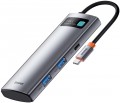USB А
The number of USB inputs located on the case of the card reader or hub (see "Type"). The number of USB ports that you will have at your disposal after connecting the device depends on this parameter. "Pure" card readers and combined models, usually, have 1,
2 and even
3 USB inputs, while hubs have
4 or more ports.
USB-C version
The USB connector interface (version) primarily characterizes the speed.
- 2.0. The outdated version 2.0 provides data transfer rates up to 480 Mbps. Found only in USB A ports.
— 3.2 gen1. Previous standard names are 3.1 gen1 and 3.0. This version provides up to 10 times the maximum speed (4.8Gbps) as well as higher power capacity, which allows you to connect power-hungry devices and large splitters.
- 3.2 gen2. Further improvement of the 3.2 gen1 standard (and, as is customary, the previous name more than once renamed 3.1 gen1 and simply 3.1), which made it possible to achieve a maximum speed of 10 Gbps and even higher power for external devices.
However, the final speed depends not so much on the input connector, but on the USB version of the hub (card reader) connection to the PC.
LAN (RJ-45)
The presence
of a LAN connector (RJ-45) makes it possible for the card reader/hub to work as a LAN adapter.
This port is commonly used for wired connection to computer networks. This connection may be preferable to wireless in some situations, but some devices (such as ultra-thin laptops) may not have a native LAN port. And in a PC, where such a port is usually installed on the back of the case, it can be much more difficult to get to it than to the USB connector. For such cases, card readers / hubs with a built-in LAN adapter are designed — usually, these are external devices connected via USB and capable of operating as an external network card.
External power supply
External USB devices require power to work, which is supplied to them through the same USB port. However, the power of such power supply is relatively low (especially in version 2.0 ports, see "Connection"), and if several external devices are connected to one port of the computer through a hub, a situation may arise when the power is not enough for their operation.
Connecting an external power supply to the hub allows you to avoid such situations: the hub receives additional power from the network and supplies power of the appropriate power to each of its inputs.
Another option for using devices with this function is charging portable equipment via USB: some models can work as stand-alone chargers that do not require connection to a computer.
USB cable compartment
A special compartment on the case of the card reader or hub (see "Type"), in which the USB cable is placed during non-working hours. Such models are compact and easy to transport due to the fact that the wire, which tends to get confused and interfere, is hidden inside the device. For objective reasons, only devices with an external connection can have
a cable compartment(see "Intended use").
Activity indicator
Light indicator, indicating that data is currently being exchanged between the memory card and the computer to which the card reader is connected. This allows you to avoid disconnecting the card reader during operation, which is fraught not only with data loss, but even damage to the device.
